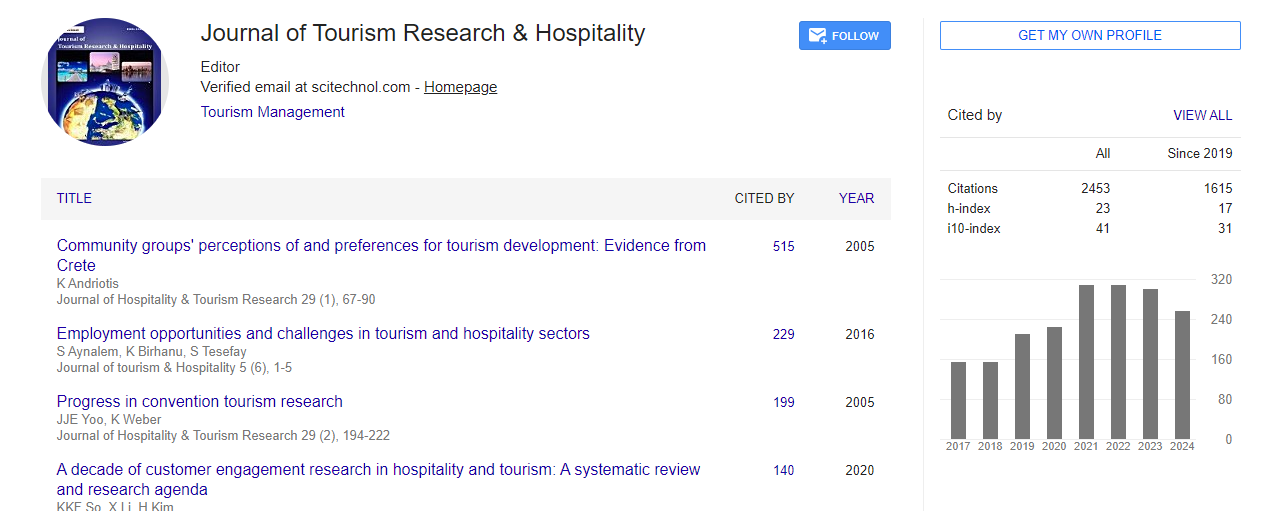Commentary, J Tourism Res Hospitality Vol: 13 Issue: 1
Threads of Tradition: Merits and Demerits in Handloom Tourism
Maya Ezra*
1Department of Tourism Management, University of Split, Split, Croatia
*Corresponding Author: Maya Ezra,
Department of Tourism Management,
University of Split, Split, Croatia
E-mail: maya.ez@efst.hr
Received date: 26 January, 2024, Manuscript No. JTRH-24-137042;
Editor assigned date: 28 January, 2024, PreQC No. JTRH-24-137042 (PQ);
Reviewed date: 14 February, 2024, QC No. JTRH-24-137042;
Revised date: 22 February, 2024, Manuscript No. JTRH-24-137042 (R);
Published date: 29 February, 2024, DOI: 10.4172/2324-9110.1000169
Citation: Ezra M (2024) Threads of Tradition: Merits and Demerits in Handloom Tourism. J Tourism Res Hospitality 13:1.
Description
Handloom tourism, a niche form of cultural tourism centered on traditional textile weaving practices, offers unique opportunities for travelers to engage with local artisans, learn about indigenous craftsmanship, and support sustainable livelihoods. However, this discusses into the multifaceted nature of handloom tourism, examining both its benefits and challenges. Through a balanced analysis of the pros and cons, stakeholders in the tourism industry can better understand the potential impacts of handloom tourism and develop strategies to maximize its benefits while reducing its drawbacks.
Handloom tourism has gained traction in recent years as travelers increasingly seek authentic cultural experiences that celebrate indigenous traditions and promote economic empowerment. This manuscript aims to provide a comprehensive overview of the pros and cons of handloom tourism, explaining its potential to drive economic development, preserve cultural heritage, and promote cross-cultural exchange, as well as the challenges it may pose in terms of sustainability, exploitation, and commodification. Handloom tourism offers travelers the opportunity to immerse themselves in the rich cultural heritage of weaving communities, learning about traditional techniques, patterns, and designs passed down through generations. By patronizing local handloom artisans and purchasing handmade textiles directly from producers, travelers contribute to the economic empowerment of weaving communities, providing sustainable livelihoods and preserving traditional craftsmanship. Handloom tourism promotes sustainable development by supporting environmentally friendly production methods, using natural fibers and dyes, reducing carbon emissions, and minimizing waste in the textile industry.
Tourism initiatives focused on handloom weaving help preserve indigenous knowledge, language, and customs, safeguarding cultural identity and promoting intergenerational transmission of traditional skills and techniques.
In some cases, handloom tourism may lead to exploitation of artisans, who may be underpaid, overworked, or subjected to unfair labor practices by middlemen or tour operators seeking to maximize profits. The commercialization of traditional handloom products for tourist consumption can lead to the commodification of cultural heritage, reducing complex weaving traditions to mere souvenirs and undermining their intrinsic value and significance. While handloom weaving is generally considered eco-friendly compared to industrial textile production, tourism-related activities such as increased demand for textiles, water consumption, and waste generation may contribute to environmental degradation in weaving communities. The influx of tourism dollars into handloom weaving communities may lead to gentrification, displacement of traditional artisans, and loss of cultural authenticity as commercial interests dominate over local needs and values.
Empowering local weaving communities through capacity building, skill development, and entrepreneurship training initiatives that enable artisans to control the production, marketing, and sale of their handloom products. Promoting responsible tourism practices such as fair trade certification, ethical sourcing, and community-based tourism initiatives that prioritize the well-being of artisans, respect local cultures, and support sustainable development. Encouraging sustainable practices in handloom weaving, such as using organic fibers, natural dyes, and water-saving techniques, while minimizing tourism-related environmental impacts through waste reduction and resource conservation measures. Preserving cultural authenticity and integrity in handloom tourism by promoting genuine interactions between travelers and artisans, encouraging meaningful cultural exchange, and appreciation for the unique heritage and traditions of weaving communities. Handloom tourism presents both opportunities and challenges for weaving communities, travelers, and destination stakeholders. By recognizing the potential benefits of cultural immersion, economic empowerment, sustainable development, and cultural preservation, while acknowledging the risks of exploitation, commodification, environmental impact, and displacement, stakeholders can work together to ensure that handloom tourism contributes to the well-being of artisans, preserves cultural heritage, and promotes sustainable tourism practices.
 Spanish
Spanish  Chinese
Chinese  Russian
Russian  German
German  French
French  Japanese
Japanese  Portuguese
Portuguese  Hindi
Hindi 

